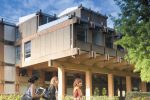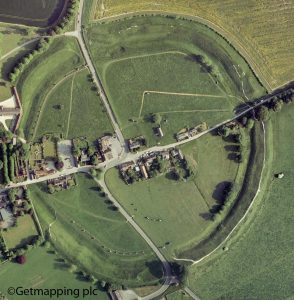 The University will shortly be able to offer the URS Building instead of studying in the Library during its major refurbishment. We will be moving furniture and IT equipment from the Library into URS so that students can study in a comfortable and quiet space away from construction works.
The University will shortly be able to offer the URS Building instead of studying in the Library during its major refurbishment. We will be moving furniture and IT equipment from the Library into URS so that students can study in a comfortable and quiet space away from construction works.
What we are doing
- Studying in URS will be quieter as it is further away from Library building works.
- The URS Building will be open 24 hours in term (except Saturday night) just like the Library is now.
- Course Collection will move into URS to maintain full access.
- Books will remain in the Library and will be borrowed as usual.
- Although Library staff will be based in URS, they will also run an information service in the Library building to help you find and borrow books there.
- Using URS means the refurbishment will be finished earlier than originally planned.
838 study spaces (including 145 computers) will move into URS along with Library staff – so there’ll always be someone on hand to help. Cafélibro will also relocate to URS.
All books (excluding the Course Collection) will stay inside the Library and will be available to use and borrow as usual. The Course Collection will move into URS and will continue to be accessible for 24 hours in term-time, as the Library offers now.
As well as providing a quiet and convenient alternative space for students, using the URS Building will mean that the length of the refurbishment programme will be shortened by approximately six months, ending mid 2019 as opposed to late 2019 / early 2020 as originally planned.
The URS Building was vacated in December 2016 in preparation for the building’s own major redevelopment – as the programme is still under revision in light of the URS Building’s grade two listing, the University is now in a position to offer it up as relief space to students. We expect URS to be available until at least August 2018.
RUSU are supportive of the move as it helps provide a suitable environment for work and study in the wake of such a major project. Ben Cooper, RUSU President, said:
“RUSU is committed to campaigning for more study space and better facilities for students on campus. We highlighted that the University must do everything it can to mitigate issues such as noise from the building work and access to books, especially for students currently studying here.
RUSU believes that this move of study space to URS is a good option and will result in less overall problems for students to face. It means that some of the noise problems will be reduced and there will be adequate study space in the busy periods whilst the Library refurbishment is being completed.”
The University is working hard to implement these plans ready for the 2017 Quiet Period. Logistics are still being finalised – we will share final plans as soon as possible. If the move is at risk of affecting the exam period it will be postponed until after exams have finished.
Don’t forget that as well as the URS Building, there are many additional alternative study spaces around campus – a full list is available online and our Free Room Finder helps identify available rooms on a daily basis. For more details of additional study space available on campus, project benefits and the latest news, please visit the Library Refurbishment Project webpage.
Rachel Redrup
for University Communications


 Digimap – contemporary Ordnance Survey maps and data, ranging from small scale base maps to detailed large scale plans
Digimap – contemporary Ordnance Survey maps and data, ranging from small scale base maps to detailed large scale plans Once registered, you can select and print maps of Great Britain using the ‘Roam’ interface from whichever collection you want. Roam includes tools to annotate your maps, and you can save them for future use. You can also measure distances and areas. Printing is possible at sizes from A4 up to A0, or you can save it as a pdf or a jpg to insert in Word.
Once registered, you can select and print maps of Great Britain using the ‘Roam’ interface from whichever collection you want. Roam includes tools to annotate your maps, and you can save them for future use. You can also measure distances and areas. Printing is possible at sizes from A4 up to A0, or you can save it as a pdf or a jpg to insert in Word. Extensive help is available from the
Extensive help is available from the  Between Monday 20 February and Monday 13 March the majority of refurbishment work will focus on re-cladding the Library’s exterior and will involve drilling – students may wish to use alternative study spaces if they are not comfortable with the noise around the Library.
Between Monday 20 February and Monday 13 March the majority of refurbishment work will focus on re-cladding the Library’s exterior and will involve drilling – students may wish to use alternative study spaces if they are not comfortable with the noise around the Library. The University will shortly be able to offer the URS Building instead of studying in the Library during its major refurbishment. We will be moving furniture and IT equipment from the Library into URS so that students can study in a comfortable and quiet space away from construction works.
The University will shortly be able to offer the URS Building instead of studying in the Library during its major refurbishment. We will be moving furniture and IT equipment from the Library into URS so that students can study in a comfortable and quiet space away from construction works. We now have access to Aerial Digimap, a new addition to the
We now have access to Aerial Digimap, a new addition to the  If you are studying archaeology it will aid visualisation of a site within its landscape, and may allow things not visible at ground level to be discerned.
If you are studying archaeology it will aid visualisation of a site within its landscape, and may allow things not visible at ground level to be discerned. Help make the Library work effectively by respecting everyone’s right to resources and space. Just a minute checking when your Library loans are due back or clearing a desk space for others can help make this term a success for everyone!
Help make the Library work effectively by respecting everyone’s right to resources and space. Just a minute checking when your Library loans are due back or clearing a desk space for others can help make this term a success for everyone!